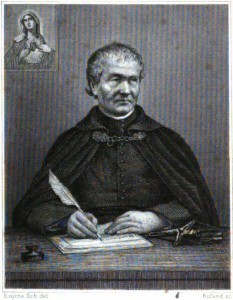Let’s begin with three stories.
 1) When I was sixteen, after my conversion, I started hungering to read books about God, Catholicism, and the saints. I found this small book on my mother’s shelf, Something Beautiful for God, about Bl. Mother Teresa. The pictures and interview really spoke to me because they showed her devotion (kneeling for hours on the hard floor in prayer); her love for people who were dying, emaciated and, to my eyes at the time, hard to look at; her simplicity (each Missionary of Charity has only two sets of clothes: one to wear and one to wash); and her joy (her smile was authentic and profound). I was deeply moved and struck by her radical life and the amazing way she loved.
1) When I was sixteen, after my conversion, I started hungering to read books about God, Catholicism, and the saints. I found this small book on my mother’s shelf, Something Beautiful for God, about Bl. Mother Teresa. The pictures and interview really spoke to me because they showed her devotion (kneeling for hours on the hard floor in prayer); her love for people who were dying, emaciated and, to my eyes at the time, hard to look at; her simplicity (each Missionary of Charity has only two sets of clothes: one to wear and one to wash); and her joy (her smile was authentic and profound). I was deeply moved and struck by her radical life and the amazing way she loved.
2) Around the same time, I started visiting The Seminary of Christ the King in Mission. In the Abbey church, there are twenty large concrete sculptures of saints. One of them depicts a famous story of St. Martin of Tours when he was a late teenager, serving in the Roman army after the year 330. “As he rode towards the town one winter day, he noticed near the gates a poor man, thinly clad, shivering with cold, and begging alms. Martin saw that none who passed stopped to help the miserable fellow. He had nothing with him but the clothes he wore, but, drawing his sword from its scabbard, he cut his great woolen cloak in two pieces, gave one half to the beggar, and wrapped himself in the other. The following night… Martin in his sleep saw Jesus Christ… dressed in the half of the cloak he had given away.” When he loved that beggar, he loved Christ and he loved like Christ! I never forgot this story.
3) When you watch The Passion of the Christ and Judas betrays Jesus with a kiss in the garden of Gethsemane, what’s powerful is Jesus’ reaction and facial expression. He has no anger that one of his apostles is betraying Him. He has, rather, a look of sadness because He loves Judas.
Start at 3:00.
All these examples show how Jesus loves in such an amazing way, and to be like Him means to love like Him. When we think of Jesus and learn more about Him, we realize that we’re supposed to love like that! But we don’t love like that. I don’t radically love like Mother Teresa; I’m not disciplined, simple and joyful. I don’t love like St. Martin of Tours; I think first of myself rather than other people. And when people hurt me, I get angry at them.
The opening prayer says, “We beseech you… may we walk eagerly in that same charity with which… your Son handed himself over to death.” But how do we walk in that same charity? One answer is: be intentional. Loving like this doesn’t come naturally, but it must be sought after and deliberately chosen. We have to be reflective, prepare and think how we’re going to act until it becomes second nature.
Matthew Kelly has five daily core habits and one of them is to do one deliberate act of love for his wife each day. He writes: “I love my wife and I tell her that every day, but I think most of us have a tendency toward selfishness. So each day I deliberately make an effort to do one thing that I know she would like me to do (which in most cases I don’t want to do) or something unexpected to demonstrate my love in practical ways. By looking to perform one deliberate act of love toward my wife each day, I end up doing many. Simply by opening our hearts and minds to this way of thinking, we begin to see opportunities for love all around us” (Off Balance, 126). That’s so beautiful! He focuses and plans so that he can love his wife like Jesus.
No saint was born a saint. They deliberately chose to imitate Jesus. Who are the most virtuous people we know? They most virtuous people are also the most intentional.
One big part of Catholic spirituality is working on one virtue every day. So many saints talk about this. If they want to grow in patience, they plan in the morning what they’re going to do that day to act patiently and ask for the grace to do it. If they want to grow in courage and boldness, they anticipate the situation, the place, and the time of how they’re going to do it.
 Venerable Francis Liebermann, when he wrote his 15-year-old nephew about how to do mental prayer, was extremely detailed on how, for example, to grow in humility. He imagines that his nephew may be struggling with pride and likes to show off in class. So he tells him that he shouldn’t just pray, “I will not be proud any more,” or “I will not say anything in praise of myself.” These are great desires, but too general. So he says, “When the teacher asks you a question in class, [and] you feel within yourself a great sense of pride, a keen desire to be admired… your resolution will be to recollect yourself for an instant when you are asked a question, to make an inner act of humility, to tell God that you renounce with all your heart all the feelings of pride” and then answer the question (Fr. Jacques Philippe, Time for God, 103-4)!
Venerable Francis Liebermann, when he wrote his 15-year-old nephew about how to do mental prayer, was extremely detailed on how, for example, to grow in humility. He imagines that his nephew may be struggling with pride and likes to show off in class. So he tells him that he shouldn’t just pray, “I will not be proud any more,” or “I will not say anything in praise of myself.” These are great desires, but too general. So he says, “When the teacher asks you a question in class, [and] you feel within yourself a great sense of pride, a keen desire to be admired… your resolution will be to recollect yourself for an instant when you are asked a question, to make an inner act of humility, to tell God that you renounce with all your heart all the feelings of pride” and then answer the question (Fr. Jacques Philippe, Time for God, 103-4)!
This might seem overly detailed, but keep in mind that the best athletes in the world do the same thing and are extremely detailed when they visualize how they’re going to execute their moves. Jack Nicklaus, arguably the best golfer ever, said, “I never hit a shot, even in practice, without having a very sharp, in-focus picture of it in my head. It’s like a color movie… you figure out what swing will fit the lie and shape of your shot… The tee shot I hit to… 71st hole at the ’72 U.S. Open at Pebble Beach… required a lot of visualization… I chose a 1-iron, and in my mind’s eye I aimed directly at the flag. I pictured the entire flight of the ball, as well as it landing on the green.”
Being specific is very helpful to doing anything well. For us, we should be as specific as we need to be. Do what works for you. For example, when we come home after a long day of work, rather than getting out of the car immediately, full of tiredness, frustration, and just wanting to go to the bathroom, change our clothes, have a good dinner, we should wait and pray. Otherwise we may get out of the car, go inside our house, not pay attention to our family, and be impatient and irritable. A much better way is to turn off the engine, pause for one full minute in the car (or before we enter our home), and pray: how are we going to treat our family when we enter the home? With a smile, with happiness to see them, asking them how their day went, offering to help with their needs. This works for me, because too many times I’ve gone home to my mother’s house and been so tired that she bears the brunt of my fatigue, selfishness, and lack of virtue. So I pause in the car and prepare how I’m going to love her better. My mom deserves better and one minute helps to be more intentional in loving her.
Last week we talked about making our morning offering, and one thing we can add to it is being intentional about how we’re going to act that day. Where do we want to act and love more like Jesus? At dinner, with the boss, with that co-worker, while driving, on the phone, before answering an e-mail, text, or post?
New habits are only formed when we deliberately choose them. These simple habits are what helped the saints. Let’s be more intentional, so that we can love like Jesus.
